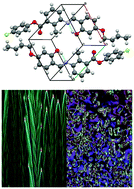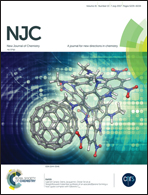Orthogonal smectic and nematic ordering in three-ring polar bent-core molecules with anti-parallel arrangement†
Abstract
We report the basic structural understanding of a new class of achiral three-ring bent-core compounds with an imine and ester linkage at the molecular bend, which are shown to exhibit nematic and orthogonal smectic phases at lower temperatures. The occurrence of the orthogonal smectic and nematic ordering has been confirmed by optical texture, DSC study and temperature dependent X-ray diffraction measurements. X-ray structure analysis in the crystalline state of one of the compounds (2-4) ascertained the antiparallel arrangement of the polar bent-core molecules in the unit cell. A stretched bent angle (∼143°), which is due to the presence of a methyl group at the molecular kink, has also been demonstrated. Moreover, the interdigitated arrangement of the pre-mesogenic Schiff's base compound, SB-C8, has been determined by SCXRD analysis. The presence of permanent dipole moment along the lateral direction of these series of compounds, determined by DFT calculation, induces polarity in the mesophase. We have successfully revealed that the bent-core compounds based on a three-ring system exhibit enhanced monolayer smectic A as well as low temperature nematic ordering upon super-cooling.



 Please wait while we load your content...
Please wait while we load your content...